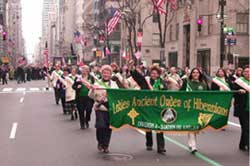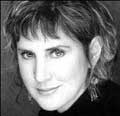| |

Traditions, folklore, history and more. If it's Irish, it's here. Or will be!
"People will not look forward to posterity who never look backward to their ancestors."
-Edmund Burke




Quotes
Library: Books, Movies, Music
Prints & Photos
Poetry
Jokes


Shops Ireland
Bunús na Gaeilge
(Basic Irish)
Circle of Prayer
Blessings
Did You Know?
Himself/Herself
Write to Us
Readers Write..
Links/Link to Us
Advertise with us
Awards & Testimonials
Submissions Guide


|
|
|
 Discovering Ireland - in New York Discovering Ireland - in New York
by Maura Conlon-McIvor
author of FBI Girl: How I Learned to Crack My Father's Code
I was Maura long before my birth. My father, a New York-born FBI agent, had savored the name since first hearing it in law school, hoping someday to bequeath it upon a daughter. Maura was a fine gift, but not always straightforward. "Nice meeting you, Mona. Is that Hawaiian?" People had a hard time with my name, and when I was young I never had the nerve to correct them.
We lived about a 40-minute drive from Hollywood, and 15-minutes to Disneyland. I didn't measure the exact miles because when you're growing up near the happiest place on earth and the town where movies are made, who wants to hear that Maura is Irish for Mary? Why bother mentioning cultural roots when I'm cycling to the noon showing of The Son of Flubber or dreaming of Tinkerbell's cool outfits? Ireland wasn't even on the map.
That is, until my Irish-born grandmother, Molly, arrived from New York City. Chuckling with her Celtic brogue, she handed me a beautifully illustrated children's book about her homeland. I can still see my first images of leprechauns, rainbows, pots of gold, double-decker buses, little girls with red hair, and shamrocks. I suspected the thrills in Ireland surpassed every highly coveted E ticket ride at Disneyland, and that the doors to this emerald kingdom didn't close at midnight. Ireland was chockablock with secrets awaiting discovery.
The clues seemed to reside back East. My grandmother, I learned, wasn't the fairy tale sort who lived in a shoe with some old man Hubbard. She was a County Clare-born farm girl who emigrated to the Bronx, the eldest of several children, and part of a New York-based clan - an Irish clan - a concept foreign to our sun-kissed housing tract. My parents, too, added their own mysterious fuel: around our house, New York was never called New York, but back home. It didn't matter that my parents had lived in California for decades, and raised five kids there.
Life took an interesting turn when I traveled to New York as a teenager. No longer was I spelling my name after introductions. I wasn't Laura, or Mona the Hawaiian, but a veritable Irish-American princess. I visited relations in Manhattan, Queens, and Brooklyn, startled and fascinated to meet others with equally Celtic names.
I met young girls who did Irish step dance. I read Irish newspapers actually published in Manhattan. I listened to my relatives sing Irish songs well into the night, wistful as they told tales about the St. Patrick's Day parade, and the many years they've marched through rain, sleet, sun or snow. My Uncle Ed, a tall Catholic priest from Brooklyn, drove me in a Checker cab throughout New York, pointing out the Irish neighborhoods, and the places where my grandparents were reared, regaling me with clan history.
I learned about my Irish American grandfather, Michael Hogan, who with an eighth grade education, worked as a stereographer for the old New York World-Telegraph and later the Post. Perhaps my grandfather chose the newspaper business because he loved words. By all accounts, he was a gregarious storyteller. Our last photograph of him was taken on his final trip to California, which coincided with St. Paddy's Day. In Los Angeles, we got to be Irish every March 17th. The icing on our cupcakes turned green with the help of food coloring, and the beef was corned, not roast. In New York, however, it seemed you could be Irish everyday.
 Years later I packed my bags, moved to Manhattan, and found a job, like my grandfather, in the publishing business. I visited the old neighborhoods, attended Irish cultural events, dined at the Pig and Whistle, always enthusiastic to discover the waiter's county of origin. These Celtic connections made back home my home. Such things I wrote in letters to my father, thanking him for my lyrical name. Years later I packed my bags, moved to Manhattan, and found a job, like my grandfather, in the publishing business. I visited the old neighborhoods, attended Irish cultural events, dined at the Pig and Whistle, always enthusiastic to discover the waiter's county of origin. These Celtic connections made back home my home. Such things I wrote in letters to my father, thanking him for my lyrical name.
Feature Image: 2002 NYC St. Patrick's Day Parade
 Bio: Bio:
Maura Conlon-McIvor graduated from The University of Iowa and has worked as a journalist, editor, and producer on both coasts. She holds a doctorate in Depth Psychology and lives with her husband in Portland, Oregon.
Her memoir - "FBI Girl: How I Learned to Crack My Father's Code" - is available from Warner books at all major booksellers, including amazon For more information, please visit http://www.fbigirl.com, or http://www.writtenvoices.com.
|
|
Fri, Sep 27, 2024
 The Galway Hooker The Galway Hooker
This unique vessel, with its distinctive curved lines and bright red sails, originated in the village of Claddagh. During the 19th century, hookers supported a significant fishing industry and also carried goods, livestock and fuel. Seán Rainey is remembered for building the last of the original boats, the Truelight, for Martin Oliver who was to become the last king of the Claddagh; as king, he was entitled to white sails on his boat. Since the mid seventies, many of the old sailing craft which were on the verge of extinction have been lovingly restored and new ones have been built. During the summer months they can be seen at festivals such a Cruinniú na mBád - the Gathering of the Boats - in Kinvara.
Click for More Culture Corner.
From an evocative new voice comes the touching childhood memoir of an Irish Catholic girl struggling to connect with her enigmatic FBI agent father. Publisher's Synopsis
Clck here for FBI Girl.
|
|
|




 The Galway Hooker
The Galway Hooker